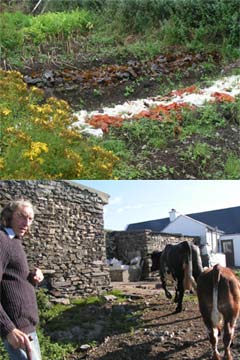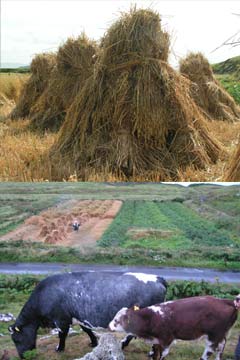A
Note on Traditional Farming in Ireland
By Margaret Lloyd
This past summer, I spent 3 months
rambling round the Irish countryside. By matter
of chance and good research, I found a gem of a
man, Bernie Winters, who lives on the west side
of Clare Island where he farms the way his father,
grandfather and 4 previous generations have farmed.
Both literature and other farmers have told me that
Bernie’s ways are typical, not of just Clare
Island, but of the west coast in general and, in
particular, any farm close to the ocean. While others
on the island weave tidbits of the ways their fathers
taught them into their conventional methods, Bernie
is definitely the only one on Clare Island, and
perhaps on all the west coast, still farming entirely
by the traditional methods. He rears 80 sheep, 2
cows (1 for milking), 13 hens, and a dog named Pinch.
A Bit of Clare Island’s
and Bernie’s History
Clare Island is a small island,
roughly 3 miles square, but among the largest of
this "365"-island archipelago of Clew
Bay, northwest Ireland. By the mid-1700s, the British
ruled the Irish parliament as well as their fields.
In 1790, over the course of 11 months, the boundary
wall that circumnavigates the center area of Clare
Island was erected. As seen by the excessive quantity
of stones that naturally overpopulate the Irish
fields, building walls was an obvious practicality
to farm the countryside. And from the number of
walls that define today’s picturesque landscape,
one can see that building stone walls was a favorite
pastime for the British in Ireland. And so the walls
stand in memory of an enslaved heritage, but they
have also been greatly appreciated and utilized
by millions of people since.
On Clare Island, this wall created a commonage where
sheep and cows were allowed to graze. "Units"
of the commonage were divvied out to the islanders
depending on their wealth and collectively used
for the island's sheep, cows and donkeys. For example:
6 sheep = 1 cow = 1 unit = 1 acre on the commonage.
Bernie’s family was given 50 units, which
he still owns and where he keeps a portion of his
sheep. With a wall, a full-time ‘herder’
was no longer necessary, and crop loss to animal
grazing became an obsolete worry. The wall was seen
as an improvement to the community because previous
to that, the animals roamed the island freely, making
no distinction between the wild and cultivated fields.
However during the famine, the island lost nearly
its entire population and has never restored its
former 900 inhabitants, but remains at a mere 140,
on a good day. And so the commonage has taken on
a new meaning ,and grazing one’s sheep and
cattle there is seen as vital to keeping the grasslands
"mowed" and fertilized.
In this century, a few significant changes of home
and farm life have occurred that make Bernie’s
way of life slightly different from his ancestors’,
as well as slightly easier. In 1912, Bernie’s
grandfather received a grant from the government
to put slate on their cottage’s roof to replace
the thatch. Bernie’s family never vaccinated
the animals, and they would lose half the flock
each year. Now that Bernie vaccinates his animals,
he only loses the odd one. This resulted in a huge
improvement in the quality of life that the sheep
live, the wear that the land bears, and the labor
and time that the farmers contribute. In 1983, Bernie’s
father installed electricity in the house, which
Bernie uses for a light bulb in the cottage and
one in the barn, a radio to listen to Irish radio1,
and small television to watch Gaelic football. Growing
up, Bernie always cooked over an open fire; however,
80% of the heat produced was lost, and so Bernie
bought a stove in the mid-1980s to more efficiently
burn the turf that he collects. And now, Bernie
receives subsidies for each head of sheep and cattle
he raises.
Bernie Winters is a tall man,
perhaps in his late 70s, living in his Irish cottage
on the sea. Made of stone, lime plaster, and the
hands of his 17th-century ancestors, this cottage
has reared 7 generations of Winters. Continuing
on the land where his family first began, Bernie
stewards that land the way they taught him, and
that’s where he showed me the ways.
On my first day we went to the
secret garden that is not hidden from the neighbors,
but rather from the gales. Billowing with force
year-round and particularly in the winter, the gales
arrive having been unobstructed by any landmass
for thousands of miles, pounding their spirits onto
the shores of western Ireland, against the stone
cottages and across Bernie’s garden. Standing
against this assault, thick hedgerows of fuchsia
and thicket are grown 9 ft tall to surround the
500-sq-ft rectangular garden containing his "lazy
beds," as Bernie calls them. They are about
4 ft wide and 15 ft long, growing onions, carrots,
beets, lettuce, potatoes, parsnips, and many herbs
including St. John’s wort, fennel, thyme,
rosemary, parsley, borage and ginger-mint. It is
only during the spring and summer that he plants
these beds, for the weather is too wet the rest
of the year for the trouble of growing. Furthermore,
it is during this time that the beds are put to
rest and given time to "replenish."
As soon as the winter rains break,
Bernie breaks the land for the first of the spring
plantings. Onions, garlic and lettuce are sown between
the 1st and 13th of March, depending on the weather.
The February frosts have always been welcome help
since they do the initial backbreaking work of cracking
and opening up the compacted winter soil. However,
in recent years, frost has been a missing tool all
across Ireland. Following the vegetable plantings,
the ubiquitous and essential spud is planted under
the spring’s new moon or on Good Friday. The
main crop is Kerr’s Pink and Cára,
while the early crop is the British Queens. In each
row, the spuds are sown 18 in apart while the rows
are laid 12 in apart. Later in the spring, carrots
are sown. Bernie says the best time to sow them
is in the middle of May.
In the late summer, changing ocean
and climatic patterns begin depositing seaweed on
the shores. One kind in particular has for centuries
been of utmost value to the farmers of western Ireland.
For several mornings, we collected the slimy bundles,
full of potash, to spread on the beds after harvesting
the spring potatoes. All the potatoes are dug out
except those which he selects for seed and leaves
in the beds until October when they are dug up,
stored until December, sprouted in the house and
planted in March and April. On those freshly forked
beds, a single layer of freshly collected seaweed
is laid and left to decay. After a month, we repeat
the process. If there is enough seaweed on the shores
for a third layer, he will collect it, but otherwise,
two is plenty. But that is not it for fertilization.
After the seaweed has rotted, the weather, too,
has turned rotten, and so the two heifers and Tom,
the donkey, are brought into the barn to live for
the winter. Their dung is collected and put on the
beds where it can rot in the rains until spring
planting. This is the centuries-old technique of
Irish fertilization.
1. The only remaining station
in Ireland that broadcasts solely in Irish, delivering
traditional music and the latest news.
2. Unique to Ireland, a cross
between soccer and rugby.

On the other side of the boithrin3 lie seaside hills
with steep cliffs, where Bernie mimics a similar
routine. Here, he has two large fields growing oats
and potatoes that are alternated each year. Only
one layer of seaweed is applied there, and ten loads
of manure are added to each ridge. Each ridge is
4-5 ft wide and 200 ft long. To Bernie, one load
is comprised of two wooden cleaves attached to the
side of Tom, filled with manure. My rough estimate
is that three five-gallon buckets fit into a cleave.
These cleaves were made by Bernie from driftwood.
Last year, he did a little experiment. Since the
sheep pastures are not cared for in any intentional
manner, their care is simply that the sheep graze,
the rain waters, and their manure fertilizes. In
a small patch, Bernie laid one layer of seaweed
last summer to rot in the weather, just as he does
in the beds. We paid a visit to that spot in August,
and the lushness, depth of color and diversity of
greens it supported were starkly richer than the
surrounding pasture. Seaweed's ability to fertilize
the land and encourage beneficial growth was clear.
It was not only potato-harvesting and seaweed-collecting
season, but also oat-cutting season. We sharpened
the sickle and set out to the fields. Bernie had
already cut half of the field during the first two
weeks of August. And so, we had the second half
to cut. To use the sickle, with a crescent loop
movement, the blade carves the section to be cut,
and the alternate hand takes the oats in a bunch
to push them in the opposite direction that the
blade then cuts through. When a large handful is
collected, it's then laid down in bundles forming
an orderly pattern of freshly cut oats that begins
to tag behind Bernie. The next row is then laid
down in a similar way; however, the oat rows are
always cut in pairs so that the oats laid always
have their grain heads facing, and even resting
on, each other. Each of these bundles makes up a
sheaf that is then tied together by gathering 4-5
stalks to wrap and twist-tie it secure. The next
step is building the conical stooks for drying.
Each one contains 20 sheaves, with 16 arranged in
a spiral and 4 upside down on top to cap it.
3. Irish for a small lane.

No Irish farming teaching is complete
unless it is done in the rain. The night before
we started up cutting the oats again, it was spilling
rain and howling wind. It did not hold back from
another bout in the early morning, and so we spent
some time watching the rain, cracking jokes and
drinking tea, waiting for it to pass and then giving
the oats an hour to wick off the heavy water. Then
we were off for the day's work; it spit a little,
but we didn't mind. We took lunch for a half-hour
while it poured rain and then kindly held back.
Consequently, we held off for an extra half-hour
and then went back to the sickle. We made good progress
and got into a rhythm under the thick cloud cover,
fresh air and sweet smell of wet grains. We persisted
through the spits again; however, this time they
got progressively harder. At that point, we each
took to a stook and ducked beside its sturdy build,
hoping for some “cap” protection as
well. Behind me, and to both sides, stooks of oats
kept us company, and in front of us, the uncut grains
stood up against the weather. After that heavier
bout of wet weather, we refrained from cutting more
and simply “stooked” the remaining sheaves,
wet as they were, into the inherently gorgeous stooks.
The field was finished the next day with a few hours
work.
Margaret Lloyd worked as an apprentice
and assistant to the garden manager at Ecology Action
for two years and has now taken to the “fields.”
At the end of October, she will be going to Guinea
with OIC International to assist in establishing
Biointensive gardens around family homes and in
communities. She teaches backyard Biointensive gardening
in Palo Alto and takes time to travel while teaching
sustainabili along the way. |